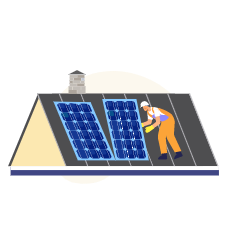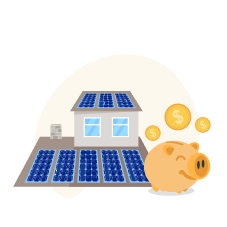Shifting to solar energy is a major financial decision, and our solar calculator is designed to break down the essential details to simplify making this decision. In this section, find out how our calculator works and the meaning of terminologies used in the tool.
The purpose of this calculator is to show how much you may spend on your existing electricity source in the long run and compare it with the potential cost of Solar energy.
Disclaimer: The user information on the electricity bill is blurred to protect the data of the user as per our policy. Please note that the information is intended to educate, and these bills may differ from state to state, as per your usage.

Monthly electricity is the amount you pay monthly for using the electricity from your service provider. We need an average monthly cost you incur for these calculations.

Energy consumption refers to the electricity you consume per month. We need this figure to calculate your approximate requirements.

This is the free space available for solar panel installation at your residence. This value is required to calculate how many solar panels can be installed at your residence.

This factor is calculated by considering the open space available in your home and average power usage.

The installation cost factor depends on the number of panels to be installed at your home.

The annual power production factor is calculated by considering the number of panels and their potential to produce power.

This factor in the result means the difference in the electricity you require and the electricity your solar panels can produce. This shows if solar can manage your requirements entirely or if you require an alternative power source to compensate for the shortage in supply.

The payback period indicates the number of years you may require to break even on your expenses of installing solar panels.

The result shows how much money you save by installing solar panels in the long run.
When applying for a loan it can be beneficial for you to plan and calculate your payments. We have created a checklist that will help you get started. Take a look:
It's a good idea to determine what you can afford to pay as monthly installments if you require or wish to take out a loan. You would not want to commit to a monthly payment that will be difficult for you to make. Additionally, evaluate whether you qualify for a loan and, if so, determine how much they offer you.
If you wish to opt for a secured loan, deciding whether you want to put up collateral is extremely important. Secured loans often offer lower rates of interest, but they involve risk. In exchange for the loan, you put up securities, such as your car or home. The lender may seize your property if you fail to pay your loan.
It is advisable to look around and evaluate loan offers from several lenders. If feasible, you can check your expected rate by applying for prequalification. It can indicate loan rates and terms without putting a formal query on your credit reports.
While comparing various offers and plans, you must also consider checking the additional charges or the processing fee. Usually, banks charge some sort of amount when giving a loan. So, it’s better to clarify the same before committing to anything.
Tax credits are an effective instrument that can lower your yearly tax burden. A tax credit can lower the amount of tax you owe or boost your tax refund by reducing your income tax liability dollar for dollar. Additionally, they differ from exemptions and deductions.
As long as the system produces electricity for a house in the US, you are eligible for the Solar Investment Tax Credit (ITC).
For systems installed between 2020 and 2022, the ITC will offer a tax credit of 26% in 2021; for systems installed in 2023, the credit will be 22%.
Gaining all tax benefits and credits the investment in solar power systems can contribute to your solar savings.

Like how the federal ITC operates, the state government also imply state tax credits. The amount and rebate differ state-by-state and they usually do not affect your federal tax credits. Also, subsidized loans and local tax exemptions also benefit the owners to maximise their profit.
![]() Financial Planning got stronger with our EMI calculator.
Financial Planning got stronger with our EMI calculator.
Homeowners make significant savings after going solar. Beyond stocks, you have many more investment possibilities. You may put your money in high-yielding savings accounts, crypto, mutual funds, government bonds and so on.

Wondering about the money that you can earn on your investment? Check out our investment calculator to know the potential gain on your savings.
Spotting the right solar companies can consume your time. However, the company needs to be legit and promising so that it upholds your solar installation sincerely. Therefore, we have listed some popular solar companies that are making a lasting impression in the solar industry.

Get the quote of the solar companies in your area
Solar panels can benefit you in many ways, including lowering your carbon footprint and raising the value of your home. According to research by the National Renewable Energy Laboratory (NREL), residences powered by solar electricity saw a boost in their home value. And, going solar is the kindest thing you can do for the environment.
It depends. The ability of a solar panel to generate power can be affected by clouds, hot weather, rain, and snow. Because it is based on how much sunshine actually reaches the solar cells. But, the solar panel still produces energy while it is in the shade.
Since the climate stays an important factor for energy production. homeowners choose to rely on the grid to prevent power supply issues.
The extra energy can be sent back to the utility grid. The power company often reimburses you for any excess electricity produced. This is called net metering. The main advantage of net metering is that your electricity is paid for at the retail price.
Calculate the price of transporting and reinstalling your solar power system at your new home. See if you are getting a justified amount if you sell the system, then take your call.
Our top 3 picks

